30 Years in Space: a look at SpaceNews’ legacyby Lon Rains — September 25, 2019
This article originally appeared in the Sept. 23, 2019 issue of SpaceNews magazine.
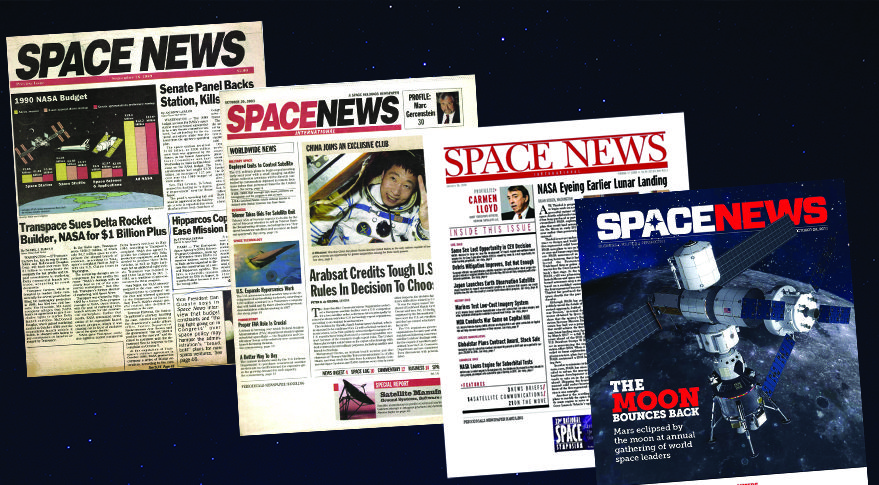 On July 20, 1989, the 20th anniversary of the Apollo 11 mission, U.S. President George Herbert Walker Bush, stood on the steps of the National Air and Space Museum and announced his administration’s intent to return humans to the moon and eventually send crews to Mars. At about the same time Bush was announcing his Space Exploration Initiative, what was then known as the Times Journal Company was making plans for a new weekly newspaper that would cover the growing space field.
On July 20, 1989, the 20th anniversary of the Apollo 11 mission, U.S. President George Herbert Walker Bush, stood on the steps of the National Air and Space Museum and announced his administration’s intent to return humans to the moon and eventually send crews to Mars. At about the same time Bush was announcing his Space Exploration Initiative, what was then known as the Times Journal Company was making plans for a new weekly newspaper that would cover the growing space field.
On Sept. 18, 1989, the first of four monthly issues were published to gauge the potential for a publication focused entirely on space. Based on the popularity of those four issues with readers and advertisers, SpaceNews was born, joining a stable of trade publications that included Defense News, Federal Times, and Army, Air Force, Navy and Marine Corps Times.
SEI figured prominently in early coverage. As Bush’s vice president and the head of the newly resurrected White House National Space Council, Quayle provided the new publication with a major scoop when he agreed to be the subject of the back-page Q&A interview for the Volume 0, No. 1 preview issue of SpaceNews.
That interview also produced one of those anecdotes that lived on in the newsroom for years. The vice president’s schedule was tight and as soon as the interview was over they had to clear the room for another meeting. In all the excitement, SpaceNews staff writer Andrew Lawler left his tape recorder in the room. Whatever was scheduled in that room after the SpaceNews interview was sensitive enough that when Lawler called to let the White House know, they immediately returned the recorder but told him they would have to keep the tape. They did, but also provide a full transcription of the interview.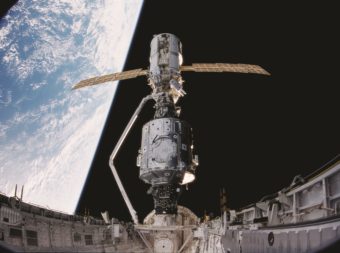 On-orbit assembly of the International Space Station commenced Dec. 6, 1998 when Space Shuttle Endeavour’s Canadarm grappled Russia’s Zarya module and attached it to NASA’s Unity module.SEI would not be the last proposal for a return to the moon or missions to Mars (or even an asteroid) that failed to be fully funded. Constellation ran into a similar fate in the last decade, as did other more modest efforts to move human spaceflight beyond low Earth orbit. Today, NASA is pushing ahead with the Artemis program and the debates in Congress ring very similar to the ones held 30 years ago and every year since.
On-orbit assembly of the International Space Station commenced Dec. 6, 1998 when Space Shuttle Endeavour’s Canadarm grappled Russia’s Zarya module and attached it to NASA’s Unity module.SEI would not be the last proposal for a return to the moon or missions to Mars (or even an asteroid) that failed to be fully funded. Constellation ran into a similar fate in the last decade, as did other more modest efforts to move human spaceflight beyond low Earth orbit. Today, NASA is pushing ahead with the Artemis program and the debates in Congress ring very similar to the ones held 30 years ago and every year since.
For the last three decades, the publication and eventually its website spacenews.com have chronicled major trends and events in military, civil and commercial space activity — the accomplishments, the failures and the endless debates. Thirty years later, much has changed and much has remained the same. It would be impossible to cover those three decades in anything less than a series of books, but the anniversary is worth taking a quick look at some of the major developments in the space industry over the last 30 years — and the even more dramatic changes in the world of journalism. This retrospective is incomplete and skips many major developments, but we’ve tried to hit the highlights.
The end of the 1980s and the early 1990s provided plenty to write about. The space shuttle had returned to flight after the disastrous Challenger accident. NASA, and the European, Canadian and Japanese space agencies were collaborating on Space Station Freedom at a time when the Soviet Union was replacing its Salyut space stations with a new modular station known as Mir. The fall of the Berlin Wall in 1989 foreshadowed the end of the Cold War and the massive increases in defense spending that began during the Reagan administration. At the same time, the commercial satellite industry was just beginning to take off.
The collapse of the Soviet Union had multiple effects on the space industry including civil space. To deter scientists in the former republics of the Soviet Union from selling their knowledge to potential U.S. adversaries, the Clinton administration encouraged and promoted a series of government-to-government and private cooperative efforts with former Soviet republics and their aerospace industries.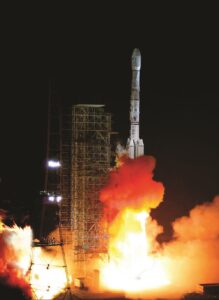 The 1995 failure of a Chinese Long March 2E carrying Apstar-6 and the 1996 failure of a Long March 3B carrying Intelsat-708 led to a U.S. crackdown on satellite technology exports after Loral and Hughes were found to have helped China troubleshoot the failures.Space Station Freedom would eventually become the International Space Station with Russia launching the first modular elements to get the program going.
The 1995 failure of a Chinese Long March 2E carrying Apstar-6 and the 1996 failure of a Long March 3B carrying Intelsat-708 led to a U.S. crackdown on satellite technology exports after Loral and Hughes were found to have helped China troubleshoot the failures.Space Station Freedom would eventually become the International Space Station with Russia launching the first modular elements to get the program going.
The best Russian launch technology also ended up in U.S. launchers, most notably the RD-180 engine that powers the first stage of the U.S.-built Atlas 5. Only in recent years has the U.S. began funding a domestic alternative to the vaunted RD-180.
Cooperation with former Soviet entities led to Lockheed Martin’s involvement in International Launch Services for the commercial utilization of the former Soviet Union’s large Proton rocket. Lockheed eventually exited that business as it formed the United Launch Alliance (ULA) joint venture with Boeing using upgraded versions of the Atlas and Delta rockets.
Launch has always been a complicated business constantly in transition.
Martin Marietta bought the Atlas business from General Dynamics in the 1990s before merging with Lockheed. Similarly, Boeing inherited the Delta business from its acquisition of McDonnell Douglas. For a time, Boeing also was involved in Ukrainian-backed Sea Launch venture to launch commercial satellites on Zenit rockets from an oil rig that was modified to provide a mobile launch platform that could sail to the equator.
Like Lockheed, Boeing eventually ended its involvement in Sea Launch and concentrated on its role in ULA.
One of the motivating factors behind Sea Launch, ILS and other launch startups was the need to lower launch costs, a major factor in the high cost of launching spacecraft into orbit or beyond. When several companies began raising money to launch large constellations of dozens of spacecraft that would need to be regularly replaced in orbit, many new and established launch companies saw the potential for a steady flow of business that would provide the kind of steady production lines to keep costs down. However, the hoped-for economies of scale never materialized.
SpaceNews has interviewed most of the major players in the space world including, to name just a few, Pete Aldridge, both as secretary of the Air Force and as under secretary of defense for acquisition, technology and logistics, Air Force Secretaries Sheila Widnall, James Roche, Michael Wynne, Deborah Lee James, and Heather Wilson and every NASA administrator starting with Richard Truly, who got the agency back on its feet after the Challenger accident. SpaceNews has brought readers interviews with influential members of Congress such as U.S. Sens. Richard Shelby, Barbara Mikulski, Kay Bailey Hutchison and Bill Nelson and plenty of industry luminaries from around the world. These include Norm Augustine, chairman of both Martin Marietta and Lockheed Martin, Pete Teets, the longtime Lockheed Martin executive who served as director of the National Reconnaissance Office after 9/11, Jean Yves LeGall, head of Arianespace and now CNES, Guiliano Berretta of Eutelsat, Romain Bausch of SES and Bernard Schwartz of Loral Space and Communications. More recently, we’ve seen entrepreneurs like Elon Musk, Jeff Bezos and Richard Branson take leading roles.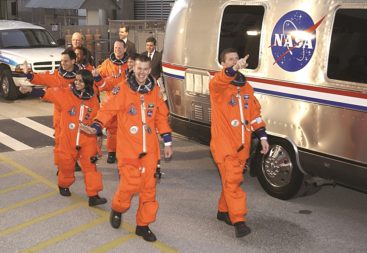 The STS-107 crew of Space Shuttle Columbia’s ill-fated 2003 mission.But long before the rise of today’s space barons, there was Rene Anselmo. The founder of PanAmSat was one of the most colorful characters SpaceNews covered in those early days. Anselmo fought hard for the right to launch a privately owned commercial satellite. At that time Intelsat (short for International Telecommunications Satellite Organization) had a global monopoly on satellite services.
The STS-107 crew of Space Shuttle Columbia’s ill-fated 2003 mission.But long before the rise of today’s space barons, there was Rene Anselmo. The founder of PanAmSat was one of the most colorful characters SpaceNews covered in those early days. Anselmo fought hard for the right to launch a privately owned commercial satellite. At that time Intelsat (short for International Telecommunications Satellite Organization) had a global monopoly on satellite services.
When a 1985 Federal Communications Commission ruling authorized private satellites, Anselmo was on his way. His initial vision was to provide Spanish language television via satellite to markets across the United States. He launched his first satellite in June 1988 with the European launch consortium Arianespace. As the business evolved, the company’s customer base grew to include TV broadcast networks, direct-to-consumer satellite TV, cable networks and many others. It was for a time the largest commercial satellite company in the world.
PanAmSat’s success eventually led to the breakup of Intelsat and other government-owned satellite service providers and to an ever-growing number of commercial startups. Ironically, a privatized Intelsat eventually purchased PanAmSat. Since then, the number of commercial operators and services has continued to grow along with ground systems for all users.
In the same era, loosened restrictions on the accuracy of commercial satellite imaging led to the creation of another commercial business.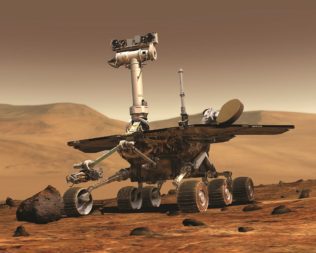 Artist’s concepts of NASA’s Opportunity rover on Mars.So has the manufacturing of spacecraft and spacecraft parts – much of it outside the United States. The U.S. crackdown on satellite and satellite technology exports that began in the late 1990s made it harder for U.S. companies to sell their products and services even to staunch U.S. allies. As a result, companies in Europe and Asia began manufacturing their own satellite parts to avoid having delivery of a spacecraft delayed.
Artist’s concepts of NASA’s Opportunity rover on Mars.So has the manufacturing of spacecraft and spacecraft parts – much of it outside the United States. The U.S. crackdown on satellite and satellite technology exports that began in the late 1990s made it harder for U.S. companies to sell their products and services even to staunch U.S. allies. As a result, companies in Europe and Asia began manufacturing their own satellite parts to avoid having delivery of a spacecraft delayed.
The high cost of space activity has been a major topic in news coverage throughout the last 30 years. NASA, the Air Force and their counterparts overseas continue to struggle to stay within budget and on schedule.
NASA Administrator Dan Goldin, facing shrinking budgets for most of his record-long tenure, emphasized smaller missions that did not take a full decade to get off the ground. His faster, better, cheaper philosophy produced mixed results but he pushed hard for innovative new approaches.
The last 30 years produced some incredible science missions. NASA’s great observatories — the Hubble Space Telescope, the Compton Gamma Ray Observatory, the Chandra X-Ray Observatory and the Spitzer Space Telescope —altered our understanding of the universe.
Hubble provided one of NASA’s more dramatic moments when NASA Administrator Sean O’Keefe decided to cancel the last Hubble servicing mission following the death of the crew of the Space Shuttle Columbia. That decision would eventually be reversed by his successor, Mike Griffin.
In the last three decades, SpaceNews has chronicled the extensive exploration of Mars and missions to Venus, Mercury, Titan, Jupiter, Saturn and Pluto. European missions such as Rosetta, BepiColombo, a joint mission with the Japan Aerospace Exploration Agency, and the Solar and Heliospheric Observatory have added immensely to our understanding of comets, Mercury and the sun. NASA Administrator Mike Griffin and Chairman of the Joint Chiefs of Staff Gen. James Cartwright brief reporters Feb. 14, 2008, on a plan to shoot down a crippled U.S. spy satellite with a ship-launched missile. The move was widely seen as response to China’s unannounced shoot down the prior year of its Fengyun- 1C weather satellite.SpaceNews also covered international space activity with an emphasis on developments in Europe, Canada, Japan, Russia and China.
NASA Administrator Mike Griffin and Chairman of the Joint Chiefs of Staff Gen. James Cartwright brief reporters Feb. 14, 2008, on a plan to shoot down a crippled U.S. spy satellite with a ship-launched missile. The move was widely seen as response to China’s unannounced shoot down the prior year of its Fengyun- 1C weather satellite.SpaceNews also covered international space activity with an emphasis on developments in Europe, Canada, Japan, Russia and China.
One of the major news stories of the early 1990s ended up having a major impact on SpaceNews and most other aerospace trade publications — the infamous “Last Supper.”
In the 1990s, there were only a handful of companies that were purely space companies. Most of the space industrial base was part of the more than 100 companies that built hardware and provided high-tech services to the Defense Department. That meant that most of the SpaceNews advertisers were divisions or other units of large defense firms like Lockheed, Martin Marietta, General Dynamics Northrop, Hughes, Raytheon, Grumman, Ford Aerospace, Westinghouse and General Electric.
In 1993, William Perry, at the time the under secretary of defense for research and engineering in the new Clinton administration, held a dinner with the CEOs of the top defense firms and let them know that the fall of the Berlin Wall and the collapse of communism was going to lead to a dramatic reduction in defense spending that would likely have to lead to major consolidations of the companies in the defense industry. It was a development that would affect the lives of many in the industry.
The number of companies (and potential advertisers) shrank dramatically in just a few years — from dozens of major companies to fewer than a dozen. It led to belt tightening in industry and belt tightening in publishing. It was one of the many seismic changes that would affect journalists over the next three decades.
When SpaceNews started in 1989, no reporters had computers at their desks. There were a couple of small rooms in the building where computers were located and it took planning and savvy to make sure one was available when you needed to write for the deadlines that occurred throughout the day. Pages were hand carried to the presses and any corrections were made manually.
All of that changed quickly by the late 1990s. Computers, which were now on every reporter’s and editor’s desk, eliminated much of the manual labor in the printing process and made it easier and faster for editors to assemble each paper.
The biggest change was the advent of the World Wide Web. Up until then, publishing had been a capital-intensive business. The web changed that. News could be published faster and cheaper than putting it into print and sending it through the mail.
Weekly, monthly and even daily publications found themselves in competition with companies and individuals who had the ability to post news — and increasingly opinions — several times a day and often within minutes of an event. The services were immediate and mostly free, making them big competition for readers.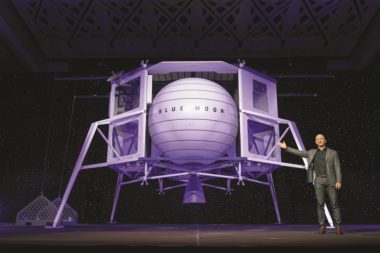 Jeff Bezos unveils the Blue Moon lander in 2019.The rush to publish put traditional reporters at a disadvantage. The time it took to properly vet a story by making phone calls and checking facts invariably meant someone else was getting the public’s attention first and multiple times a day. News has not been the same since, nor has the life of reporters and editors.
Jeff Bezos unveils the Blue Moon lander in 2019.The rush to publish put traditional reporters at a disadvantage. The time it took to properly vet a story by making phone calls and checking facts invariably meant someone else was getting the public’s attention first and multiple times a day. News has not been the same since, nor has the life of reporters and editors.
To stay competitive without giving up traditional journalistic standards, reporters for print publications now have companion duties to file first on the publication’s website and to provide material for Twitter, Facebook, podcasts, video and any other products publishers can think of to stay profitable. It means that the time reporters must cover events, interview newsmakers and write in-depth stories is even more constrained than it used to be.
Accepted practices that allow aggregators to publish headlines and the lead paragraphs of other companies’ news stories — or slap a clickbait headline on a quick rewrite — without compensating them has made it even easier to compete for readers at a very low cost.
All of these factors combined to make stressful jobs much more stressful. These stresses are not unique; publications throughout the world have felt the same pressures. SpaceNews survives, while many daily publications did not.
It is hard to predict what newsrooms and news coverage will look like in 2049, but it is certain to be different. Hopefully, the importance of quality in-depth reporting will remain at the heart of what readers want.Lon Rains was a member of the original staff of SpaceNews and was its first Soviet Space program and advanced technologies reporter. He served as deputy editor for three years and as editor for 15 years.Source:
https://spacenews.com/30-years-in-space-a-look-at-spacenews-legacy/